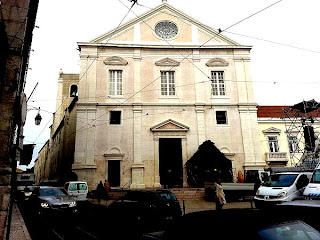I love reading the stories surrounding these historic churches ... and this church has a pretty fascinating tale to tell … In 1505 Lisbon was being ravaged by the plague, which had arrived by ship from Italy. The king and the court were even forced to flee Lisbon for a while. The site of São Roque, outside the city walls became a cemetery for plague victims. At the same time the king of Portugal, Dom Manuel I (reigned 1495–1521), sent to Venice for a relic of St. Roch, the patron saint of plague victims, whose body had been translated to that city in 1485. The relic was sent by the Venetian government, and it was carried in procession up the hill to the plague cemetery.
Then in 1515 the inhabitants of Lisbon erected a shrine on the site to house the relic. A “Plague Courtyard” for the burial of plague victims adjoined the shrine and was also erected in 1527. At about the same time a Brotherhood (or confraternity) of St. Roch was established to oversee and take care of the shrine. Made up of people from all classes, the Brotherhood still exists today, and maintains the Chapel of St. Roch in the present church.
In 1540, after the founding of the Society of Jesus in the 1530s, King John III (1521–1557) of Portugal invited them to come to Lisbon and the first Jesuits arrived in the same year, and looking for a permanent location for their main church, they selected the Shrine of St. Roch as their favored site. In 1553 and after prolonged negotiations, John III organized the relinquishment of the shrine to the Jesuits. The agreement with the Brotherhood, however, included the creation of a chapel for St. Roch in the new building, and the retention of St. Roch as the patron saint of the new church. The small shrine was inadequate for the Jesuits and planning began immediately for a new church building that emphasized their notion of simplicity and functionality.
In 1759 the Jesuits – implicated in a revolt of the nobility against King José I and his prime minister - were expelled from Portuguese territory and the Igreja de São Roque was confiscated along with the attached buildings and residences. Nine years later, by a Royal Charter, the property was given to the Santa Casa da Misericórdia ( Holy House of Mercy ) who still owns and operates the site today as a centre caring for the poor. The church also continues to function, and part of the Jesuit residence was turned into a museum ( the Museu de São Roque - see next post ... ).
The painted ceiling of the nave is a trompe l’oeil designed to give the
illusion of barrel vaulting supported by four large arches covered in volutes
and other decorative elements. Between the arches are painted squared balconies
and “above” these balconies are three huge domes or cupolas rising on rings of
open arches and columns. Most of this was painted between 1584 and 1586 by
Francisco Venegas, royal painter to King Phillip II. The ceiling near the front
of the church was damaged in the 1755 Earthquake and was rebuilt and repainted.
The entire ceiling was restored in 2001 and the paint cleaned or repaired.
São Roque’s collection of 16th and 17th-century
reliquaries ( shrines for displaying sacred relics – such as bones from saints
…) are now exhibited in the two reliquary altars ( Holy Martyrs – male - on the
left or Gospel side, and Holy Martyrs – female -on the right or Epistle side )
flanking the chancel as well as being partially integrated into the decoration
of some of the other chapels. The reliquaries at St. Roch are of different
shapes, generally depending on the relic they house: arms, male and female
torsos, urns, chests. The majority, with their pontifical certificates and
letters, are of great historical and artistic value.
Male reliquaries ...
Female reliquaries ...
Overwhelmed
by all this glitter I staggered blinded outside in search of sustenance, and
after a relaxing hot chocolate and sweety thing, made my way next
door into the Museu Sao Roque for another blinding dose of stunning 16th century Portuguese religion ... join
me on the next posting ....























No comments:
Post a Comment
Note: Only a member of this blog may post a comment.